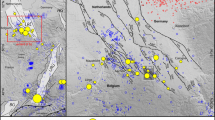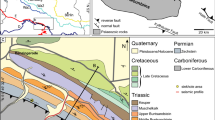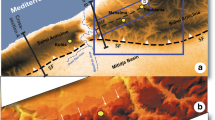Abstract
In Sweden, knowledge of the location and timing of glacially induced faulting and seismicity is critical to effective engineering of a long-term nuclear disposal facility. To improve understanding and modeling of the complex ice-induced and tectonic stresses associated with glacially induced faulting, field studies detailing the location and timing of movement of such structures are required. Although the fault has not been confirmed in the bedrock, multi-proxy surficial geologic evidence indicates that the recently discovered scarp in Bollnäs is such a structure. Machine-excavated trenches across the scarp reveal landsliding down the scarp and, in one location, faulted and vertically offset fine-grained glacial sediments. The presence of water-escape structures in trenches excavated on a topographic high strongly suggests a co-seismic origin derived from earthquake magnitudes >5.5. Numerous landslides in till exist in the region as well. Four slopes with landslides were examined in detail, and the factors of safety for these slopes indicate stable conditions and suggest a seismic trigger. Basal radiocarbon dates from peat bogs located stratigraphically above the landslides provide minimum limiting ages for the co-seismic landslides. The oldest date indicates sliding prior to 10,180 calendar years before the present. The proposed Bollnäs Fault is 400 km south of the so called Lapland Fault Province. To date, it is the southernmost confirmed glacially induced fault in Sweden. The results of this study are consistent with existing modeling results that indicate fault instability in this region of central Sweden following deglaciation.









Similar content being viewed by others
References
Albrecht L, Kübler L (2011) Bedrock Map 15G Bollnäs, scale 1:250 000. Geological Survey of Sweden, K312
Ambraseys NN (1988) Engineering seismology. Earthq Eng Struct Dyn 17:1–105
Bäckblom G, Stanfors R (1989) Interdisciplinary study of post-glacial faulting in the Lansjärv area northern Sweden 1986–1988. SKB Technical Report 89–31
Berglund M (2005) The Holocene shore displacement of Gästrikland, eastern Sweden: a contribution to the knowledge of Scandinavian glacio-isostatic uplift. J Quat Sci 20:519–531
Björck S (1995) A review of the history of the Baltic Sea, 13.0–8.0 ka BP. Quatern Int 27:19–40
Bödvarsson R, Lund B (2003) The SIL seismological data acquisition system -as operated in Iceland and in Sweden. In: Takanami T, Kitagawa G (eds) Methods and applications of signal processing in seismic network operations. Lecture Notes in Earth Sciences 98, Springer, Berlin
Boggs S (1995) Principles of Sedimentology and Stratigraphy. Prentice Hall, Englewood Cliffs
Bungum H, Olesen O, Pascal C, Gibbons S, Linidholm C, Vestøl O (2010) To what extent is the present seismicity of Norway driven by post-glacial rebound? J Geolog Soc 167:373–384
De Geer G (1940) Geochronologia Suecica, principles. Kungliga Svenska Vetenskapsakademiens Handlingar 18(6), Almqvist & Wiksells Boktryckeri AB, Stockholm
DeGeer G (1912) A geochronology of the last 12 000 years. Congres de Geologie International, Compte Rendu 11. Stockholm 1910:241–253
Ek B-M (2010) Map of the quaternary deposits 14F Rättvik SV, scale 1:100 000. Geological Survey of Sweden, K210
Galli P (2000) New empirical relationships between magnitude and distance for liquefaction. Tectonophysics 324:169–187
Jakobsson M, Björk S, O’Regan M, Floden T, Greenwood SL, Swärd H, Lif A, Ampel L, Koyi H, Skelton A (2014) Major earthquake at the Pleistocene-Holocene transition in Lake Vättern, southern Sweden. Geology. doi:10.1130/G35499.1
Jibson RW (1996) Use of landslides for paleoseismic analysis. Eng Geol 43:291–323
Johnston AC (1987) Suppression of earthquakes by large continental ice sheets. Nature 330:467–469
Kujansuu R (1964) Nuorista siirroksista Lapissa. English summary: recent faults in Lapland. Geologi 16:30–36
Lagerbäck R (1978) Neotectonic structures in northern Sweden. GFF 100:263–269
Lagerbäck R (1990) Late Quaternary faulting and paleoseismicity in northern Fennoscandia with particular reference to the Lansjärv area, Northern Sweden. GFF 112:333–354
Lagerbäck R (1992) Dating of late quaternary faulting in northern Sweden. J Geolog Soc 149:285–291
Lagerbäck RH, Henkel H (1977) Studier av neotektonisk aktivitet i mellersta och norra Sverige, flygbildsgenomgång och geofysisk tolkning av recenta förkastningar (Studies of neotectonic activities in central and northern Sweden, review of aerial photos and geophysical interpretation of recent faults). KBS TR 19, Svensk Kärnbränslehantering AB, Skbf/Kbs. Stockholm, Sweden
Lagerbäck R, Sundh M (2008) Early Holocene faulting and paleoseismicity in northern Sweden, Sveriges geologiska undersökning, Research Paper C 836, 84 pp. SGU, Sweden
Lagerbäck R, Witschard F (1983) Neotectonics in northern Sweden—geological investigations. SKB Technical Report 83–58
Lagerbäck R, Sundh M, Svedlund J-O, Johansson H (2005) Forsmark site investigation: Searching for evidence of late or postglacial faulting in the Forsmark region. SKB Report R-05-51
Lantmäteriet (2010) Produktbeskrivning: GSD-Höjddata, grid 2+
Lundqvist J (1998) Weichsel-istidens huvedfas. In: Fredén C (ed) Sveriges Nationalatlas, Berg och jord, pp 124–135
Lundqvist J, Lagerbäck R (1976) The Pärve Fault: a late-glacial fault in the Precambrian of Swedish Lapland. GFF 98:45–51
Mikko H (2010a) Map of the Quaternary Deposits 14G Ockelbo SV, scale 1:100 000. Geological Survey of Sweden, K213
Mikko H (2010b) Map of the Quaternary Deposits 14G Ockelbo NV, scale 1:100 000. Geological Survey of Sweden, K212
Mikko H (2011a) Map of the Quaternary Deposits14F Rättvik NO, scale 1:100 000. Geological Survey of Sweden, K346
Mikko H (2011b) Map of the Quaternary Deposits 15G Bollnäs NV, scale 1:100 000. Geological Survey of Sweden, K214
Mikko H, Backström A (2010) Map of the Quaternary Deposits14F Rättvik NV, scale 1:100 000. Geological Survey of Sweden, K345
Mikko H, Dahlberg N (2010) Map of the Quaternary Deposits 14F Rättvik SO, scale 1:100 000. Geological Survey of Sweden, K211
Mikko H and Wiberg B (2011) Map of the Quaternary Deposits 15G Bollnäs SV, scale 1:100 000. Geological Survey of Sweden, K216
Mikko H, Rodhe L, Wiberg B (2011) Map of the quaternary deposits 15G Bollnäs SO, scale 1:100 000. Geological Survey of Sweden, K217
Mörner NA (1980) A 10,700 years’ paleotemperature record from Gotland and Pleistocene/Holocene boundary events in Sweden. Boreas 9:283–287
Mörner NA (1985) Liquefaction and varve deformation as evidence of paleoseismic events and tsunamis. The Autumn 10,430 BP case in Sweden. Quat Sci Rev 15:939–948
Mörner NA (2004) Active faults and paleoseismicity in Fennoscandia, especially Sweden. Primary structures and secondary effects. Tectonophysics 380:139–157
Muir Wood R (1989) Extraordinary deglaciation reverse faulting in northern Fennoscandia. In: Gregersen S, Basham PW (eds) Earthquakes at North-Atlantic Passive Margins: Neotectonics and Postglacial Rebound. Kluwer, Dordrecht, pp 141–173
Muir Wood R (1993) A review of the seismotectonics of Sweden. SKB technical report pp 93–13
Obermeier SF (1996) Use of liquefaction-induced features for paleoseismic analysis: an overview of how seismic liquefaction features can be distinguished from other features and how their regional distribution and properties of source sediment can be used to infer the location and strength of Holocene paleo-earthquakes. Eng Geol 44:1–76
Olesen O, Blikra LH, Braathen A, Dehls JF, Olsen L, Rise L, Roberts D, Riis F, Faleide JI, Anda E (2004) Neotectonic deformation in Norway and its implications: a review. Norw J Geol 84:3–34
Reimer PJ, Bard E, Bayliss A, Beck JW, Blackwell PG, Bronk Ramsey C, Buck CE, Cheng H, Edwards RL, Friedrich M, Grootes PM, Guilderson TP, Haflidason H, Hajdas I, Hatté C, Heaton TJ, Hogg AG, Hughen KA, Kaiser KF, Kromer B, Manning SW, Niu M, Reimer RW, Richards DA, Scott EM, Southon JR, Turney CSM, van der Plicht J (2013) IntCal13 and MARINE13 radiocarbon age calibration curves 0–50000 years calBP. Radiocarbon. doi:10.2458/azu_js_rc.55.16947
Ritter DF, Kochel RC, Miller JR (2002) Process geomorphology. McGraw Hill, New York
Rodhe L, Mikko H, Wahlroos, J-E (2013) Map of the quaternary deposits 15F Voxna SO, scale 1:100 000. Geological Survey of Sweden, K432
Stewart IS, Sauber J, Rose J (2000) Glacio-seismotectonics: ice sheets, crustal deformation and seismicity. Quat Sci Rev 19:1367–1389
Strömberg B (1989) Late Weichselian deglaciation and clay varve chronology in east-central Sweden. Geological Survey of Sweden, Series Ca, Nr 73
Stuiver M, Reimer PJ (1993) Extended 14C data base and revised CALIB 3.0 14C age calibration program. Radiocarbon 35:215–230
Sukotjo S, Sträng T (2005) Bedrock Map 14G Ockelbo NO, scale 1:50 000. Geological Survey of Sweden, K22
Sundh M, Mikko H (2011) Map of the Quaternary Deposits15G Bollnäs NO, scale 1:100 000. Geological Survey of Sweden, K215
Sutinen R (2005) Timing of Early Holocene Landslides in Kittilä, Finnish Lapland. Geol Surv Finland Spec Pap 40:53–58
Sutinen R, Hyvönen E, Kukkonen I (2014a) LiDAR detection of paleolandslides in the vicinity of the Suasselkä postglacial fault, Finnish Lapland. Int J Appl Earth Observ Geoinform 27:91–99
Sutinen R, Hyvönen E, Middleton M, Ruskeeniemi T (2014b) Airborne LiDAR detection of postglacial faults and Pulju moraine in Palojärvi, Finnish Lapland. Glob Planet Change 15:24–32
Valera JE, Traubenik ML, Egan JA, Kaneshiro JY (1994) A practical perspective on liquefaction of gravels. In: Prakash S, Dakoulas P (eds) Ground failures under seismic conditions. American Society Civil Engineers Special Publication 44, pp 241–257
Wells DL, Coppersmith KJ (1994) New empirical relationships among magnitude, rupture length, rupture width, rupture area, and surface displacement. Bull Seismol Soc Am 18:974–1002
Wu P (1999) Intraplate earthquakes and postglacial rebound in eastern Canada and Northern Europe. In: Wu P (ed) Dynamics of the ice age earth, a modern perspective. Trans Tech Publications, Zurich, pp 443–458
Acknowledgments
Funding for this project was provided by the Swedish Nuclear Fuel and Waste Management Co. (Svensk Kärnbränslehantering AB). The authors appreciate the support, enthusiasm, and involvement of R. Munier in this project from funding, to fieldwork, to commenting on the manuscript. T.V. Lowell read and commented extensively on an earlier draft of this manuscript. His critical review and suggestions led to a much improved document. Thanks is also extended to R. Lagerbäck for sharing his experience in the field.
Author information
Authors and Affiliations
Corresponding author
Rights and permissions
About this article
Cite this article
Smith, C.A., Sundh, M. & Mikko, H. Surficial geology indicates early Holocene faulting and seismicity, central Sweden. Int J Earth Sci (Geol Rundsch) 103, 1711–1724 (2014). https://doi.org/10.1007/s00531-014-1025-6
Received:
Accepted:
Published:
Issue Date:
DOI: https://doi.org/10.1007/s00531-014-1025-6




